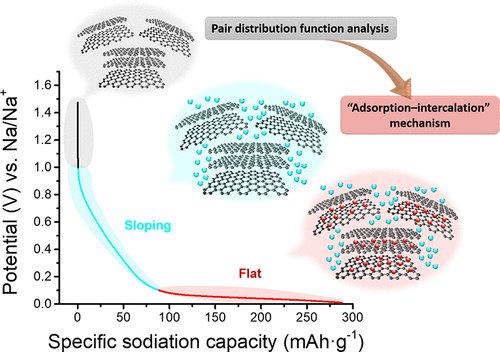当前位置:
X-MOL 学术
›
Chem. Mater.
›
论文详情
Our official English website, www.x-mol.net, welcomes your
feedback! (Note: you will need to create a separate account there.)
Correlation of Structure and Performance of Hard Carbons as Anodes for Sodium Ion Batteries
Chemistry of Materials ( IF 7.2 ) Pub Date : 2019-09-05 , DOI: 10.1021/acs.chemmater.9b01768 Aurora Gomez-Martin 1 , Julian Martinez-Fernandez 1 , Mirco Ruttert 2 , Martin Winter 2, 3 , Tobias Placke 2 , Joaquin Ramirez-Rico 1
Chemistry of Materials ( IF 7.2 ) Pub Date : 2019-09-05 , DOI: 10.1021/acs.chemmater.9b01768 Aurora Gomez-Martin 1 , Julian Martinez-Fernandez 1 , Mirco Ruttert 2 , Martin Winter 2, 3 , Tobias Placke 2 , Joaquin Ramirez-Rico 1
Affiliation

|
Hard carbons are the material of choice as negative electrode in sodium ion batteries. Despite being extensively studied, there is still debate regarding the mechanisms responsible for storage in low- and high-potential regions. This work presents a comprehensive approach to elucidate the involved storage mechanisms when Na ions insert into such disordered structures. Synchrotron X-ray total scattering experiments were performed to access quantitative information on atomic ordering in these materials at the nanoscale. Results prove that hard carbons undergo an atomic rearrangement as the graphene layers cross-link at intermediate temperatures (1200–1600 °C), resulting in an increase of the average interplanar distance up to 1400 °C, followed by a progressive decrease. This increase correlates with the positive trend in the reversible capacity of biomass-derived carbons when processed up to 1200–1600 °C due to an increased capacity at low potential (≤0.1 V vs Na/Na+). A decrease in achievable sloping capacity with increasing heat-treatment temperature arises from larger crystalline domains and a lower concentration of defects. The observed correlation between structural parameters and electrochemical properties clearly supports that the main storage of Na ions into a hard-carbon structure is based on an adsorption–intercalation mechanism.
中文翻译:

钠离子电池用硬碳作为阳极的结构与性能的相关性
硬碳是钠离子电池中负极的首选材料。尽管进行了广泛的研究,但仍存在关于负责低电位和高电位区域存储的机制的争论。这项工作提出了一种综合的方法,以阐明当Na离子插入这种无序结构时所涉及的存储机制。进行了同步加速器X射线全散射实验,以获取有关这些材料在纳米级的原子有序化的定量信息。结果证明,随着石墨烯层在中间温度(1200–1600°C)下交联,硬碳会发生原子重排,导致平均平面间距增加到1400°C,然后逐渐减小。+)。随着热处理温度的升高,可达到的倾斜能力降低是由于较大的晶畴和较低的缺陷浓度引起的。观察到的结构参数与电化学性能之间的相关性清楚地表明,Na离子进入硬碳结构的主要存储是基于吸附-嵌入机制的。
更新日期:2019-09-05
中文翻译:

钠离子电池用硬碳作为阳极的结构与性能的相关性
硬碳是钠离子电池中负极的首选材料。尽管进行了广泛的研究,但仍存在关于负责低电位和高电位区域存储的机制的争论。这项工作提出了一种综合的方法,以阐明当Na离子插入这种无序结构时所涉及的存储机制。进行了同步加速器X射线全散射实验,以获取有关这些材料在纳米级的原子有序化的定量信息。结果证明,随着石墨烯层在中间温度(1200–1600°C)下交联,硬碳会发生原子重排,导致平均平面间距增加到1400°C,然后逐渐减小。+)。随着热处理温度的升高,可达到的倾斜能力降低是由于较大的晶畴和较低的缺陷浓度引起的。观察到的结构参数与电化学性能之间的相关性清楚地表明,Na离子进入硬碳结构的主要存储是基于吸附-嵌入机制的。































 京公网安备 11010802027423号
京公网安备 11010802027423号